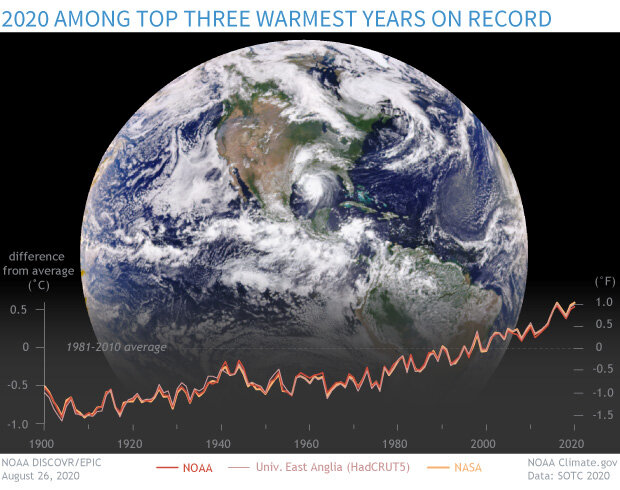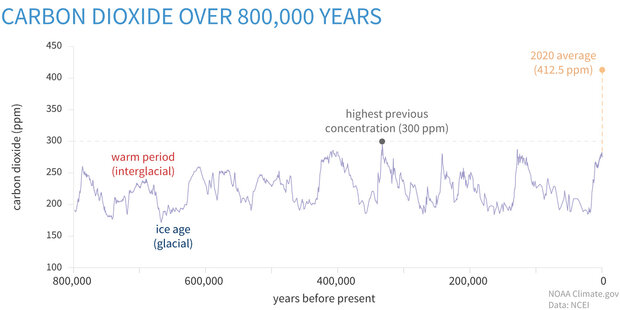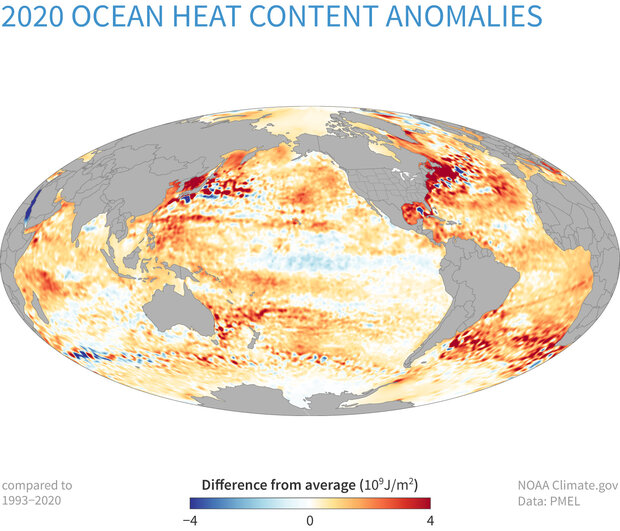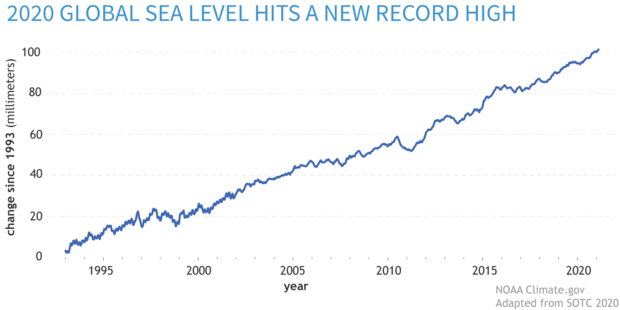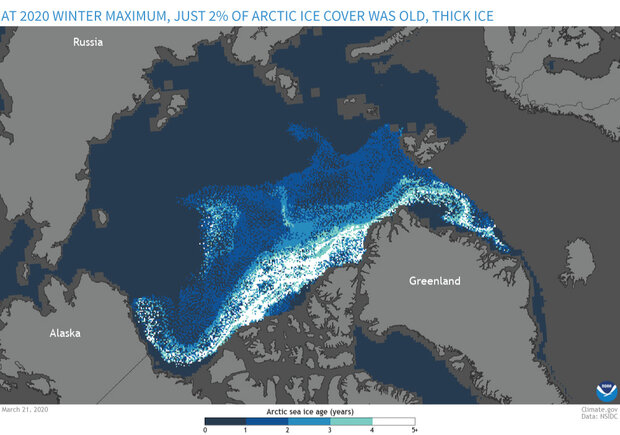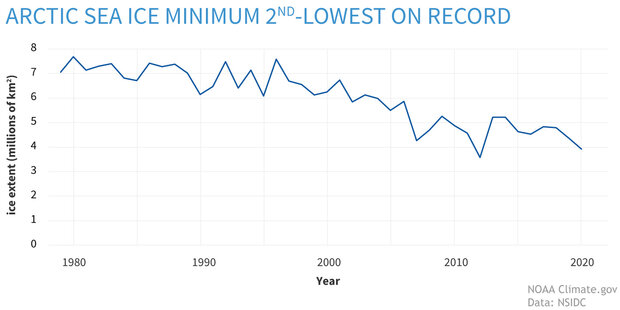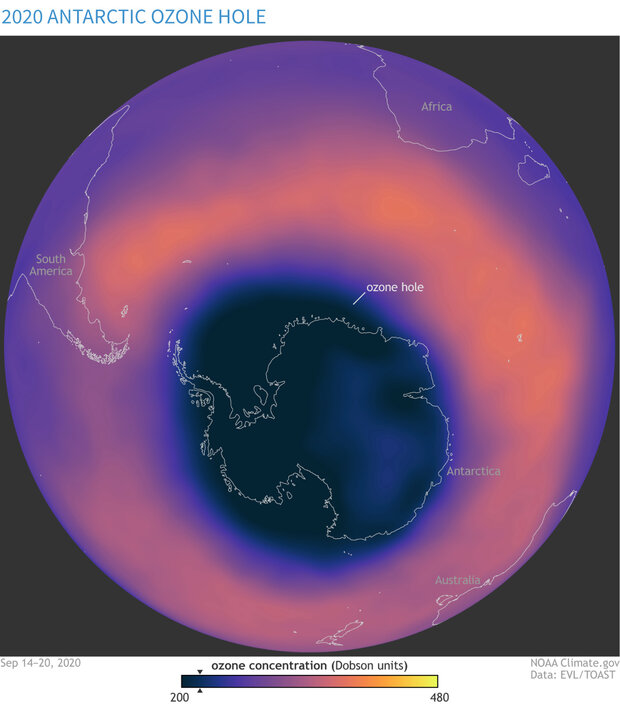Reporting on the State of the Climate in 2020
Global surface temperature each year compared to the 1981-2010 average from three datasets: NOAA (red line), NASA (orange), and University of East Anglia (pink). The background image from the NOAA DISCOVR/EPIC mission shows Hurricane Laura coming ashore in Louisiana on August 26, 2020. Image by NOAA Climate.gov, adapted from State of the Climate in 2020. [Correction (08-25-21): The original version of this graphic and the caption indicated the temperature data were compared to the 20th-century average. They are compared to the 1981-2010 average.]
A new State of the Climate report confirmed that 2020 was among the three warmest years in records dating to the mid-1800s, even with a cooling La Niña influence in the second half of the year. New high temperature records were set across the globe. The report found that the major indicators of climate change continued to reflect trends consistent with a warming planet. Several markers such as sea level, ocean heat content, and permafrost once again broke records set just one year prior. Notably, carbon dioxide (CO2) levels in the atmosphere also reached record highs in 2020, even with an estimated 6%–7% reduction of CO2 emissions due to the economic slowdown from the global pandemic.
These key findings and others are available from the State of the Climate in 2020 report released online today by the American Meteorological Society (AMS).
The 31st annual issuance of the report, led by NOAA National Centers for Environmental Information, is based on contributions from more than 530 scientists from over 60 countries around the world and reflects tens of thousands of measurements from multiple independent datasets (full report). It provides a detailed update on global climate indicators, notable weather events and other data collected by environmental monitoring stations and instruments located on land, water, ice and in space.
The report’s climate indicators show patterns, changes and trends of the global climate system. Examples of the indicators include various types of greenhouse gases; temperatures throughout the atmosphere, ocean, and land; cloud cover; sea level; ocean salinity; sea ice extent and snow cover.
Report highlights include these indications of a warming planet:
- Greenhouse gases were the highest on record. As they do each year, and again in the midst of a global pandemic that slowed economic activity around the world, the major greenhouse gas concentrations, including CO2, methane (CH4) and nitrous oxide, rose to new record high values during 2020. The global annual average atmospheric CO2 concentration was 412.5 parts per million.
Atmospheric carbon dioxide concentrations (CO2) in parts per million (ppm) for the past 800,000 years. On the geologic time scale, the increase to today’s levels (orange dashed line) looks virtually instantaneous. Graph by NOAA Climate.gov based on data from Lüthi et al., 2008, via the NOAA NCEI Paleoclimatology Program.
This was 2.5 parts per million greater than 2019 amounts and was the highest in the modern 62-year measurement record and in ice core records dating back as far as 800,000 years. The year over year increase of methane (14.8 parts per billion) was the highest such increase since systematic measurements began.
- Global surface temperature was near-record high. Annual global surface temperatures were 0.97°–1.12°F (0.54°–0.62°C above the 1981–2010 average, depending upon the dataset used). This places 2020 among the three warmest years since records began in the mid- to late 1800s.This was the warmest year on record without the presence of El Niño. The seven warmest years on record have all occurred in the past seven years, since 2014. The global average surface temperature has increased at an average rate of 0.14°F (0.08°C) per decade since the start of the record; since 1981, the rate of increase has been more than twice as high.
- Upper atmospheric temperatures were record or near-record setting. In the region of the atmosphere just above Earth’s surface, the globally averaged annual lower troposphere temperature equaled the record high of 2016. In the layer above that, the lower stratosphere temperature continued to decline, as expected in a warming world.
- Sea surface temperatures were near-record high. The globally averaged 2020 sea surface temperature was the third highest on record, surpassed only by 2016 and 2019, both of which were associated with El Niño conditions.
- Global upper ocean heat content was record high. Globally, upper ocean heat content reached record highs in 2020 in the upper layer measured from the surface to 2,300 feet (700 meters), according to four of the five datasets analyzed in the report. This record heat reflects the continuing accumulation of thermal energy in the top 2,300 feet of the ocean.
This map shows heat content anomalies—differences from the long-term average—in the top 700 meters (~2,100 feet) of the global ocean. Positive anomalies mean the ocean gained heat in 2020 (orange); negative anomalies mean the ocean lost heat energy (blue) in 2020. NOAA Climate.gov image, based on data provided by John Lyman.
Ocean heat content was also record high in the deeper layer beneath, from 700 to 2,000 meter depth, according to all five datasets. Oceans absorb more than 90% of Earth’s excess heat from global warming. The warmer upper ocean waters can drive stronger hurricanes and increase melting rates of ice sheet glaciers around Greenland and Antarctica.
- Global sea level was highest on record. For the ninth consecutive year, global average sea level rose to a new record high and was about 3.6 inches (91.3 millimeter) higher than the 1993 average, the year that marks the beginning of the satellite altimeter record.
Increase in global mean sea level based on satellite altimeter data. NOAA Climate.gov, adapted from Figure 3.15a in State of the Climate in 2020.
Global sea level is rising at an average rate of 1.2 inches (3.0 centimeter) per decade due to changes in climate. Melting of glaciers and ice sheets, along with warming oceans, account for the trend in rising global mean sea level.
- Oceans absorbed a record amount of CO2. The ocean absorbed about 3.0 billion metric tons more CO2 than it released in 2020. This is the highest amount since the start of the record in 1982 and almost 30% higher than the average of the past two decades. More CO2 stored in the ocean means less remains in the atmosphere, but this also leads to increasing acidification of the waters, which can greatly harm or shift ecosystems.
The report also documents key regional climate and climate-related events.
- The Arctic continued to warm; minimum sea ice extent was near-record low. The annual mean surface air temperature for the Arctic land areas was the highest in the 121-year record, at 3.8°F (2.1°C) above the 1981–2010 average. This was the seventh straight year with an annual temperature more than 1°C higher than the 1981–2010 average. On June 20, a temperature of 38°C was observed at Verkhoyansk, Russia (67.6°N), provisionally the highest temperature ever measured within the Arctic Circle. The Arctic continues to warm at a faster pace than lower latitudes. With the warmth came fires. The Arctic experienced its highest fire year in terms of the amount of carbon released into the atmosphere, surpassing the record set in 2019 by 34%. The majority of the fires occurred in northeastern Siberia where abnormally high temperatures also occurred.
At the annual maximum ice extent in March 2020, only 2% of the Arctic ice cover consisted of old, thick ice (white). Most of the ice cover consist of ice that was less than a year old—i.e. seasonal ice that doesn’t survive the summer. NOAA Climate.gov image, based on data from the National Snow and Ice Data Center.
In March, when sea ice reached its annual maximum extent, thin, first-year ice comprised ~70% of the ice; the thickest ice—usually more than four years old—had declined by more than 86% since 1985 to make up just 2% of total ice in 2020. When the minimum sea ice extent was reached in September, it was the second smallest in the 42-year satellite record, behind 2012.
Sea ice concentration across the Arctic Ocean on September 15, 2021, the day of the summer minimum. The yellow line shows the median extent (middle value) of the ice cover between 1981 and 2020. NOAA Climate.gov image based on data from the National Snow and Ice Data Center.
The Northern Sea Route along the Siberian coast was open for about 2.5 months, from late July through mid-October, compared to less than a month typically.
- Antarctica saw extreme heat and a record-long ozone hole. Extreme warmth was observed across parts of Antarctica during austral summer, contributing to a major heat wave. On February 6, Esperanza Station reached 64.9°F (18.3°C), the highest temperature ever recorded on the continent, surpassing the previous record set in 2015 by 2.0°F (1.1°C). The warmth also led to the largest late-summer surface melt event in the 43-year record, affecting more than 50% of the Antarctic Peninsula and impacting elevations as high as 1,700 meters.
Later in the year, the Antarctic polar vortex was unusually strong and persistent, with polar temperatures in the stratosphere at record low levels throughout November and December. This strong vortex was linked to the longest-lived ozone hole over the Antarctic region, which lasted to the end of December. Record-low ozone values in late austral spring and early summer led to unusually high levels of UV radiation across the Antarctic region.
Ozone concentration over Antarctica the week of September 14–20, 2020. To allow comparisons from year to year, experts define the "ozone hole" as the area in which ozone levels are below 220 Dobson Units (dark blue, marked with black triangle on color bar). NOAA Climate.gov image, based on TOAST data from the NOAA Environmental Visualization Lab.
- Tropical cyclones were well-above average overall. There were 102 named tropical storms during the Northern and Southern Hemisphere storm seasons, well above the 1981–2010 average of 85. Three tropical cyclones reached Saffir–Simpson scale Category 5 intensity. The North Atlantic hurricane basin recorded a record 30 named storms, surpassing the previous record of 28 in 2005. Seven of those storms became major hurricanes, matching 2005 for a record number. Major Hurricanes Eta and Iota made landfall along the eastern coast of Nicaragua in nearly the same location within a two-week period, impacting over seven million people across Central America. In the western North Pacific, Super Typhoon Goni was the strongest tropical cyclone to make landfall in the historical record and led to the evacuation of almost one million people in the Philippines. Very Severe Cyclonic Storm Gati made landfall over Somalia, the first storm of such intensity to do so.
Geographical Regional Highlights
- North America
- Mexico reported its warmest year in its 49-year record, tied with 2017 and 2019.
- The contiguous United States reported its fifth-warmest year. Alaska reported its coolest year since 2012, although it was still warmer than its 1981–2010 average. The annual temperature for Alaska has increased at an average rate of 0.50°C per decade over the past half century.
- Most of Mexico was drier than average in 2020 due to the late onset of a weak North American Monsoon and a lack of tropical cyclones on the Pacific side. The United States was dominated by warm, dry air in the West and an active storm track that brought wet conditions to much of the East. In Canada, the Avalon Peninsula in Newfoundland was hit by a strong blizzard with hurricane force winds in January. The storm contributed to the snowiest January on record for Saint John’s.
- Central America and the Caribbean
- The annual average temperature over the Caribbean basin was the second highest since the start of the record in 1891. Annual average maximum temperatures were record high for stations in The Bahamas, Dominica, and Trinidad and Tobago.
- Powerful Category 4 Hurricanes Eta and Iota impacted Central America in November, making landfall along the eastern coast of Nicaragua in nearly the same location within a two-week period.
- South America
- Most of South America had above-average temperatures during the year. Central South America reported its second-warmest year for the region in its 61-year record, behind only 2015. During a strong heat wave in October, the city of São Paulo, Brazil, recorded four of its five all-time daily maximum temperatures.
- The Bolivian lowlands suffered one of its most severe droughts on record during autumn. Drought also spanned the Chaco and Pantanal in Bolivia, Paraguay and southern Brazil. The Paraguay River shrank to its lowest levels in half a century. A decadal “mega drought” in south-central Chile continued through its 11th year, with extreme conditions in the most populated areas. Argentina reported its driest year since 1995.
- Africa
- Seychelles, an archipelago in the Indian Ocean off East Africa, observed its highest annual temperature in the record dating to 1972. In West Africa, Nuguru, Nigeria, observed about 80 days of maximum temperatures exceeding 104°F (40°C) in 2020, surpassing its previous record of 77 days in 2019.
- Extremely heavy rains in April triggered widespread flooding and landslides in Ethiopia, Somalia, Rwanda and Burundi. The Lake Victoria region was the wettest in its 40-year record, and the lake itself rose more than three feet (one meter) due to the excessive rain.
- Europe
- The year 2020 was the warmest year on record for Europe, with all five of the warmest years occurring since 2014. Record warmth was reported for Belarus, Belgium, European Russia, Estonia, Finland, France, Kazakhstan, Lithuania, Luxembourg, the Netherlands, Norway, Poland, Spain, Sweden, Switzerland and Ukraine.
- In February, almost all areas in Europe observed temperatures more than 5°F (3°C) higher than average. Biarritz in southern France reached a temperature of 80.0°F (26.6°C), which is higher than the monthly average for July and August.
- The Middle East experienced an extreme drought during autumn, with most places reporting 0%–20% of their typical precipitation in September and no precipitation at all in October.
- Asia
- In 2020, Japan and Russia each observed their highest annual temperature on record. In northern Siberia, annual temperatures were more than 9°F (5°C) above average across vast territories. The average winter temperature for all of Russia was 5°C above normal. In East Asia, Hong Kong, China, reported 50 hot nights, where the daily minimum temperature did not dip below 82.4°F (28.0°C), and 47 very hot days, where the daily maximum temperature reached at least 91.4°F (33.0°C), both of which set new annual records.
- The 2020 Southwest Asian Monsoon season (June–September) was the wettest since 1981, coincident with the emergence of La Niña. The Meiyu season (July–August), a typical rainy season over the Yangtze and Huaihe River Valleys of China, doubled its typical duration by two months in 2020. The May–October total rainfall averaged over the area was the most since the start of the record in 1961. Associated severe flooding affected about 45.5 million people.
- As is typical, several tropical cyclones impacted Asia in 2020. Super Typhoon Goni was the strongest storm on record anywhere in the world to make landfall. More than one million people were evacuated from its path in the Philippines. Eight tropical cyclones directly affected Vietnam. Typhoon Molave was one of the most intense storms to reach the country in the past 20 years.
- Oceania
- Most locations across Micronesia were drier than average during the first half of 2020 and wetter than average at all locations in the second half. For the year, Kosrae was record wet, while Kapingamarangi and Saipan observed near-record low annual rainfall totals.
- The last days of 2019 and first days of 2020 saw particularly hazardous fire weather in eastern Australia, where multiple fires had been burning since austral spring 2019. The emergence of La Niña was a welcome change for the Australian region, with this phase of ENSO contributing to increased rainfall over the continent, after a very significant 2019/20 fire season. Even with increased rainfall, this was Australia’s fourth-warmest year in its 111-year record. Both November and spring as a whole had record high temperatures.
- Aotearoa, New Zealand, reported its seventh-warmest year since records began in 1909, in part due to its warmest winter on record. La Niña conditions contributed to higher temperatures in the latter part of the year. From late-December 2019 through February 2020, several areas across New Zealand observed record or near-record dry spells, that is, at least 15 consecutive days with less than one millimeter of rain each day. A 64-day dry spell, the longest on record, was reported in Blenheim, a town on the northern tip of the South Island.
The State of the Climate in 2020 is the 31st edition in a peer-reviewed series published annually as a special supplement to the Bulletin of the American Meteorological Society. The journal makes the full report openly available online.
Other references
Lüthi, D., M. Le Floch, B. Bereiter, T. Blunier, J.-M. Barnola, U. Siegenthaler, D. Raynaud, J. Jouzel, H. Fischer, K. Kawamura, and T.F. Stocker. (2008). High-resolution carbon dioxide concentration record 650,000-800,000 years before present. Nature, Vol. 453, pp. 379-382. doi:10.1038/nature06949.
